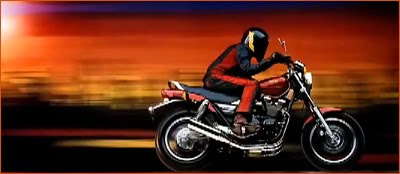 We used to have to walk five miles to school and back. Barefoot. In the snow. Uphill. Both ways.
We used to have to walk five miles to school and back. Barefoot. In the snow. Uphill. Both ways.I'm just kidding -- we had shoes.
But while you are finishing up your Boot Camp shots (which, by the way, are due today) howzabout a little inspiration from back in the '80's, when we didn't have no hotshot digital cameras?
Take this pan shot of a Yamaha bike, for instance, the original of which is absolutely perfect despite the crappy video screen grab version seen above.
What if I told you this was done on an 8x10 view camera -- using just four small quartz lights -- and no Photoshop, either.
Hit the jump to watch it happen via two, ten-minute videos.
__________
Today: A Full, Dean Collins Shoot
I have said before and I will say again that there is no better source for learning how to create sophisticated light than by studying work of Dean Collins. Through the wide range of shoots on his Best of Dean Collins DVDs, he shows you example after example of how seemingly impossible lighting challenges can be broken down into a series of small, solvable problems.
Are you ever gonna be asked to shoot a speeding motorcycle with an 8x10 view camera without Photoshop? Not likely.
But the point is, this is just another problem that can be solved with a thorough understanding of the principles of lighting. And if you understand those principles, you can solve -- or reverse engineer -- just about anything you come across, with ease.
So, how do you perfectly pan a fast-moving bike with an eight-by-frickin'-ten view camera?
Simple: You don't, because the bike is not moving. In fact, the bike is the only thing in the frame that is staying completely still.
The beauty of watching problem-solving at high-end levels is that your challenges start to become ridiculously easy by comparison. Which is one reason I recommend his educational materials so strongly.
And today, a big 'thank you' to the folks at Software Cinema for porting one of the twenty shoots on the 'best of' DVDs to YouTube in its entirety.
Its 20 minutes long, and shows how Collins handles such problems as creating the illusion of speed where none exists, getting highlights on the dull, black tires and creating absolutely perfect specular highlights before Photoshop.
And, IMO, the best things about these types of shoots is not that they teach you how to solve a specific set of problems. It is that they make you realize that you can learn to light anything.
So, without further yakkin':
Part 2:
You can see more -- including another video of a more down-to-earth shoot, at Software Cinema: The Best of Dean Collins on Lighting.








No comments:
Post a Comment